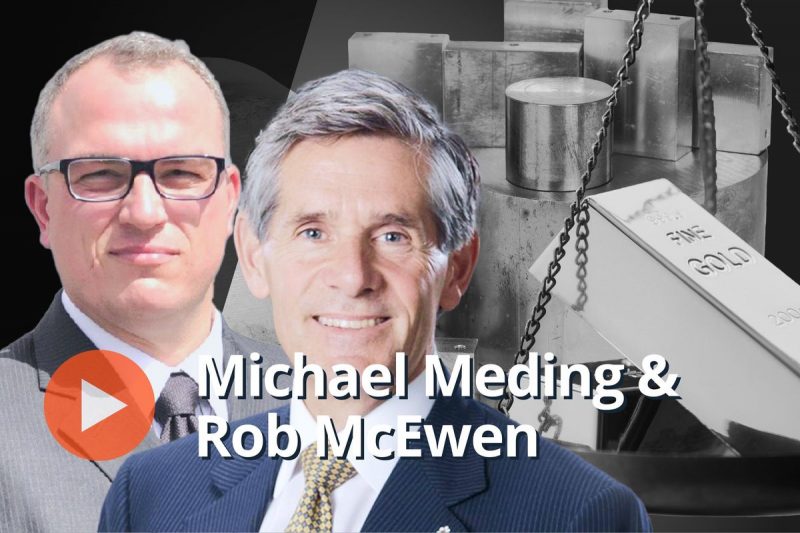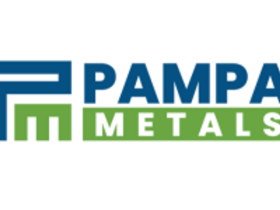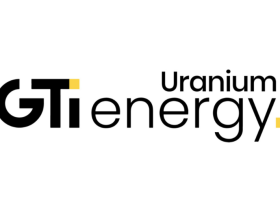Gold has fallen from the heights it saw earlier this year, staying below US$2,000 per ounce so far in June.
Is the yellow metal just taking a breather before it moves higher? Rob McEwen believes the answer is ‘yes.’
While discussions around potential declines in interest rates and inflation have diverted some attention from gold, the chairman and chief owner of McEwen Mining (TSX:MUX,NYSE:MUX) said the burden of government and corporate debt remains massive.
‘And then the monetary stimulation. There’s still the world awash in liquidity, and people go, ‘Well, where do I put my money?’ You’re seeing central banks — and a lot of them are part of the BRICS group that Russia and China have been putting together — have been buying gold, and they’ve been buying it with the dollars they held in their reserves. I think you’re going to see more of that happening. There’s going to be more turbulence in the currency market as we go forward,’ he said.
Discussions around de-dollarization have intensified in recent months, and McEwen said gold will benefit as the American currency falls from favor. He sees China and Russia spearheading that transition as they work to transact in yuan and rubles.
‘People are going, ‘Well, why am I holding onto dollars if I can use other currencies? I’ll just step away from that.’ That’s what you’re seeing. I think it’s going to take some time, because neither of those currencies have the liquidity that the dollar has, but there’s a definite move that way,’ said McEwen, adding that he sees gold gaining further traction as a neutral store of value.
Copper price decoupled from fundamentals
As the founder of Goldcorp, McEwen has a long track record in the gold sector, and McEwen Mining produced 133,300 gold equivalent ounces in 2022. But the company also has a focus on copper and owns about 52 percent of McEwen Copper.
Speaking about the red metal, Michael Meding, who is vice president and general manager at McEwen Copper, said that over the last few years the metal’s price has decoupled from fundamentals — despite supply concerns and strong underlying demand, copper is facing short-term headwinds. However, he pointed to McEwen Copper’s recent deal with Stellantis (NYSE:STLA) as evidence that big-name players are eager to secure supply of copper. After a US$155 million investment, the carmaker, which manufactures brands such as Chrysler, Fiat, Jeep and Maserati, now has a 14.2 percent stake in McEwen Copper.
McEwen Copper is moving forward at the advanced-stage Argentina-based Los Azules project, where it plans to produce 100,000 metric tons of 99.9 percent pure copper cathode annually starting in 2027. As part of its deal with the company, Stellantis will have the option to purchase a percentage of output from Los Azules once it is in production.
‘Carmakers are starting to realize they need metals to use in all those future electric vehicles that we see coming up. And beyond those electric vehicles, you have all the demands from infrastructure — it’s not only the cars where you need additional copper, there’s a conventional demand. You also need the charging infrastructure. You need the generation capacity, whether it’s conventional or non-conventional. So you need all those additional raw materials,’ Meding said.
He added that for Stellantis part of the appeal of investing in McEwen Copper was that both parties have similar views on carbon neutrality — Stellantis is looking to become carbon neutral by 2038, and Los Azules will have a low-carbon footprint.
With production at Los Azules targeted for 2027, McEwen Copper has several balls in the air. Meding said that the company’s largest-ever drill campaign is about to conclude, with results to be shared in the coming months. The company is also in the process of completing an environmental assessment, and plans to publish a updated preliminary economic assessment in June. A feasibility study is targeted for completion by the end of 2024 or start of 2025.
‘There will be a lot of news coming out regarding our drilling results, making it an interesting period,’ said Meding.
When will gold stocks start to move?
For its part, McEwen Mining recently reduced its debt by 39 percent, paying off lead lender Sprott Resource Lending early. According to McEwen, the company will now save about $2.2 million a year in interest expenses.
However, his goal is to rid the company of debt entirely. ‘I keep looking back to Goldcorp when I was running it. When I bought control of the company, it had about $50 million worth of debt, and there was a little clause in the statement — if there was a change of control of management, the debt was due immediately. That was a bit of a surprise,’ he said.
‘So we ran around, and Citibank called their debt, and we went and renegotiated with the Royal Bank of Canada (TSX:RY,NYSE:RY). But I said I don’t want to be in that position again, so we paid down our debt, and for probably the last 10 years while I was at Goldcorp, we had no debt at all. Ideally, that’s where I’d like to get to as we go forward.’
When asked when investors may start to see gold stocks start to move, McEwen pointed out that since September his company has outperformed gold and silver prices, as well as the VanEck Gold Miners ETF (ARCA:GDX) and VanEck Junior Gold Miners ETF (ARCA:GDXJ) — but he understands why market participants might be impatient.
‘I’d say, ‘Don’t get disheartened. This is a space you want to be in.’ Usually, right after the PDAC, the gold stocks go down for a period, and then through the summer they wander around not really getting too excited. But come September, they take off again. So now is the time to accumulate rather than bemoan the fact that it’s down,’ he added.
Does the mining industry need to ‘Uberize’?
In closing, McEwen spoke about the future of the mining industry, saying he wants to see it ‘Uberize.’
‘Before Uber (NYSE:UBER) came along, you had smelly taxis with often rude drivers (and) cars in poor repair. You had a bumpy ride, and you never knew when they were going to arrive. Uber comes along and addresses all of those issues, and everybody says, ‘Oh, and I don’t even have to pay with cash,” he explained during the conversation.
‘Can we go back as an industry and say, ‘Well, you know, those (issues) were all in the past, and what we’re doing in the future is addressing most of those concerns — and we’re going to do it in a very responsible, ecological way.’
In McEwen’s opinion, changing public opinion will be necessary if the world is going to be successful in meeting demand for the metals needed for electrification and other parts of the green energy transition.
‘(Meding) spoke of the deficit in copper, but that’s true for all sorts of other metals required for the technologies we need to capture renewable energy,’ said McEwen. ‘The timelines to bring these mines on are getting longer and longer. So we have to turn some or most of those people who hate us into lovers. However, they won’t get there quickly.’
Securities Disclosure: I, Charlotte McLeod, hold no direct investment interest in any company mentioned in this article.





